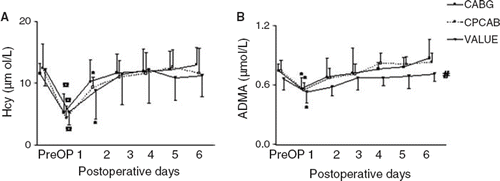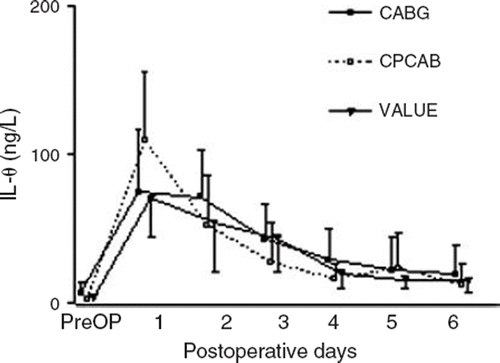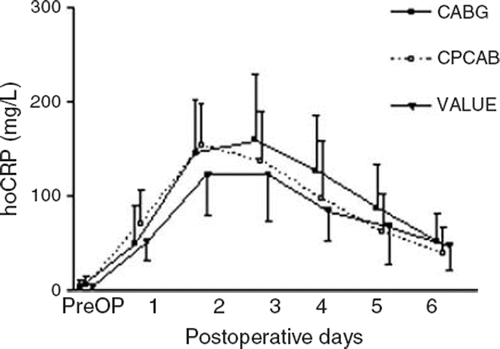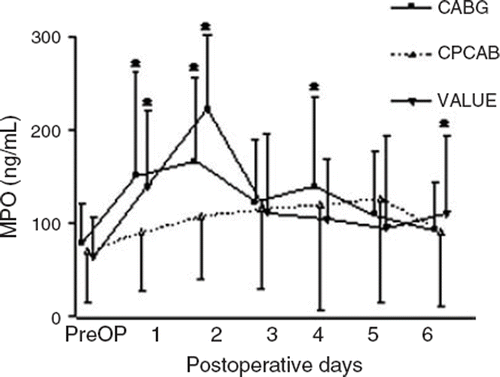Abstract
Objectives. To compare inflammatory and oxidative stress time course during the first week after different types of cardiac surgery. Design. In patients undergoing coronary artery bypass grafting with cardiopulmonary bypass (CABG) or on the working heart (OPCAB) and aortic valve replacement (VALVE) blood samples for high-sensitive C-reactive protein (hsCRP), interleukin-6 (IL-6), myeloperoxidase (MPO), asymmetric dimethylarginine (ADMA) and homocysteine (Hcy) were taken preoperatively and for six consecutive postoperative days. Results. Exploitation of cardiopulmonary bypass (CABG, VALVE groups), but not OPCAB, resulted in significant rise of MPO for two postoperative days. ADMA and Hcy changed in parallel fashion, being significantly decreased in the first postoperative morning and rising to the preoperative levels thereafter. In comparison with coronary artery disease patients, VALVE group had lower preoperative levels of ADMA and different postoperative time course. Postoperative concentrations of IL-6 and hsCRP were increased significantly in all groups and remained elevated during the first postoperative week. Conclusions. Cardiac surgery results in extensive and complex inflammatory/oxidative stress reponse regardless of the method or type of surgical procedure used. Myeloperoxidase could be one of the parameters to evaluate the cardiopulmonary bypass-associated inflammatory and oxidative stress response.
Cardiopulmonary bypass (CPB) and cardioplegic cardiac arrest are used extensively in cardiac surgery, and resulting inflammatory response is widely described. Coronary artery bypass grafting performed on the working heart without CPB, i.e. off-pump (OPCAB) reduces the systemic inflammatory response, but does not prevent it completely (Citation1). Reduced inflammatory response, however, does not result in more favourable clinical outcome, except reduced rate of atrial fibrillation after OPCAB (Citation2). CPB-induced inflammation is characterised by an early activation of polymorphonuclear leukocytes (PMN), which leads to enchanced release of reactive oxygen species accompanied by progressive increase in plasma PMN elastase, interleukins (IL-6 and IL-8) and C-reactive protein (CRP) (Citation3,Citation4). Besides others, myeloperoxidase (MPO), a heme enzyme expressed and secreted by PMNs has been described as a valid marker of neutrophil activation. MPO is linked to both inflammation and oxidative stress by its location in leukocytes and its role in catalysing the formation of oxidising reactive species. Whether it shows any differences during operations performed with or without CPB, is not well described. Recently, the value of MPO as a useful biomarker for cardiovascular risk estimation was emphasised (Citation5). In this conjunction, dynamics of MPO related to cardiac surgery is of particular interest.
Elevated level of circulating asymmetric dimethylarginine (ADMA), an endogenic inhibitor of nitric oxide synthase, has been suggested as a marker of endothelial dysfunction (Citation6). High levels of ADMA lead to increased resting vascular tone and decreased myocardial vasodilatory capacity, and are associated with increased all-cause mortality in the community (Citation7). Immediately after coronary artery bypass grafting (CABG) significant decrease in ADMA and homocysteine (Hcy) levels occur (Citation8,Citation9). Whether these potentially beneficial changes are of temporary or persistent nature is not fully clear. In our previous studies we have investigated time course of systemic oxidative stress during open heart surgery and demonstrated that all lipid peroxidation parameters return to preoperative levels by the following day (Citation10,Citation11).
The aim of the present study was to compare time course of both inflammatory and oxidative stress during the first week after different types of cardiac surgery (CABG, OPCAB, aortic valve replacement).
Patients and methods
Patients
The study design was approved by the institutional Ethics Review Committee on Human Research, and a written informed consent was obtained from all patients the day before operation. Consecutive adult patients scheduled for three different types of primary elective cardiac operations were included and formed three groups: (a) conventional coronary artery bypass grafting with cardiopulmonary bypass – CABG; (b) coronary artery bypass grafting on the working heart – OPCAB; (c) aortic valve replacement due to non-rheumatic calcific aortic stenosis – VALVE. The patients undergoing combined cardiac surgery, presenting type I or II diabetes mellitus or having serum creatinine over 150 μmol/L were not included in the study. All the patients in the VALVE group had coronary angiography performed and no significant coronary stenoses detected. All medications except salicylates were allowed up to the morning of the operation.
Anaesthesia and operative procedure
Standardised anaesthetic technique with fentanyl, midazolam and pipecuronium was used in all cases. To correct the hemodynamic fluctuations during the procedure metoprolol, nitroglycerin or phenylephrine were administered as needed.
CABG and VALVE. Cardiopulmonary bypass was performed with a roller pump (Stöckert Instrumente GmbH, Munich, Germany) and membrane oxygenator ((Medtronic, Minneapolis, Minnesota, USA) under mild hypothermia (nasopharyngeal temperature 33–35°C). For cardioplegia, St.Thomas’ solution II was given both ante- and retrogradely. Infusion was repeated after completion of each anastomosis or at least every 20 minutes. Both distal and proximal anastomoses were performed under a single cross-clamping period.
OPCAB.Pericardial traction sutures and elevating gauze pads were used to facilitate visibility and access to the left and right sides of the heart during the grafting procedure. The Octopus heart stabiliser system (Medtronic, Minneapolis, Minnesota, USA) was used for myocardial stabilisation. Intracoronary shunt (Medtronic Inc., Minneapolis, Minnesota, USA) was inserted immediately after opening the coronary artery in all cases. In case of haemodynamic detoriation, the right pericardium was opened to the pleural cavity and intravenous boluses of phenylephrine together with infusions of crystalloid or colloids were given. No conversion to cardiopulmonary bypass was needed.
Biochemical markers
Blood samples for high-sensitive C-reactive protein (hsCRP), interleukin-6 (IL-6), myeloperoxidase (MPO), asymmetric dimethylarginine (ADMA) and homocysteine (Hcy) were taken preoperatively and in the mornings of six consecutive postoperative days. Blood was centrifuged immediately after sampling and serum stored at -80°C until analyses.
hsCRP was determined using C-reactive protein-particle enhanced turbidimetric assay (COBAS INTEGRA C-Reactive Protein (Latex) (CRPHS), Roche Diagnostics GmbH, Mannheim, USA). IL-6 was measured with a solid-phase, enzyme-labeled, chemiluminescent sequential immunometric assay and Hcy by competitive immunoassay (Immulite 2000, Siemens Medical Solutions Diagnostics, Los Angeles, USA). MPO was determined in plasma using an enzyme-linked immunosorbent assay kit (BIOXYTECH1 MPO-EIA, OXIS Research, Portland, USA). ADMA was determined using the competitive ADMA-ELISA assay (DLD Gesellschaft für Diagnostika und Medizinische Geräte mbH; Hamburg, Germany).
Statistical analysis
Categorical variables are presented as frequency of counts and the results for the biochemical markers are given as mean with standard deviations. Repeated measures analysis of variance (ANOVA) was used to determine differences between CABG, OPCAB and VALVE groups. The unstructured or compound symmetric correlation structures were used whereas the most suitable structure was determined by the Akaike information criterion. Where needed, the values were transformed using square root transformation to remove skewness. In case of significant differences between groups, Bonferroni multiple comparisons were implemented. Contrast analysis was used to compare preoperative baseline with postoperative time-points. P-values below 0.05 were considered significant.
Results
Patients and operative procedures
Patients’ demographic data and data for the operative procedure are presented in One patient in the VALVE group had combined operation as decided by the surgeon during the operation and was therefore excluded from the study. As a result nine patients had aortic valve replacement performed. There was no mortality nor major complications (myocardial infarction, stroke, low cardiac output syndrome or renal failure) observed.
Table I. Characteristics of patients.
Inflammation- and oxidative stress-related markers
Interleukin-6. Preoperative arterial levels of IL-6 were within reference limits (<3.4 ng/L). In the postoperative period, the concentration of IL-6 increased significantly in all groups and remained higer at all time-points when assessed ( ). The maximal values were observed in the first postoperative morning in all groups. The time course of IL-6 release did not differ between groups.
High-sensitive CRP
Two patients in the CABG group and one patient in OPCAB and VALVE groups had preoperative values above the consensus reference interval for adults (<5.0 mg/L). Mean (minimum and maximum) preoperative values were as follows:
CABG 2.64 (0.51, 7.77)
OPCAB 4.92 (0.82, 28.22)
VALVE 2.76 (0.85, 10.87).
In the postoperative period the concentrations of hsCRP increased significantly in all groups and remained higher at all time-points when assessed (). The time course was identical in all groups.
Myeloperoxidase
Preoperative values were within endemic reference values (76±35 ng/mL) in all groups. In groups, where CPB was exploited (i.e. CABG, VALVE), the concentrations of MPO were elevated 2 to 3 times in the first and second postoperative mornings. The operative procedure without exploitation of CPB did not have any impact on the postoperative myeloperoxidase release ().
Asymmetric dimethylarginine and homocysteine
As expected, baseline concentrations of Hcy (coronary artery artery disease patients: mean (SD), 12.0 (2.9) (xmol/L, minimum value 7.6 μmol/L, maximum value 21.3 nmol/L; VALVE patients: mean (SD), 12.2 (2.6) μmol/L, minimum value 8.9 μmol/L, maximum value 16.0 μmol/L) ranged from low- to high risk levels for coronary artery disease (Citation12). The values did not differ between patients having coronary artery disease or valve pathology, but were on the very high end or exceeded the proposed reference values of 5–12 μmol/L in both groups.
Concentrations of ADMA and Hcy changed in parallel fashion, being significantly decreased in the first postoperative morning and rising to the preoperative levels thereafter (A, B). The baseline levels of ADMA, measured the day before surgery, were lower in the VALVE group (coronary artery artery disease patients: mean (SD), 0.74 (0.09) μmol/L, minimum value 0.58 μmol/L, maximum value 0.95 nmol/L; VALVE patients: mean (SD), 0.67 (0.11) μmol/L, minimum value 0.48 μmol/L, maximum value 0.81 μmol/L); p=0.05. Also, the time courses of concentrations of ADMA in the OPCAB and CABG patients differed significantly from that of VALVE patients.
Figure 4. Perioperative time course of Hcy (panel A) and ADMA (panel B) concentrations. # – time course of VALVE group differs significantly (p=0.03) from both coronary artery bypass groups. ◻ – lower values (p<0.01) and *(p<0.05) in comparison with preoperative baseline (PreOP) values. Data are presented as mean (SD).

Discussion
Inflammatory/oxidative stress response after cardiac surgery is complex. Inflammation comprises general systemic (hsCRP, IL-6) component, both inflammation and oxidative stress involve cellular (MPO) and impaired metabolism related components (ADMA, Hcy).
Cardiac surgery is associated with acute stimulation of different physiological systems involved in activation of the inflammatory response. Each of these systems may have an effect on the other systems resulting in changed pro- and anti-inflammatory balance. As we have shown previously, the pro-inflammatory cytokine IL-6 has significantly increased already by the 5th minute after declamping the aorta during CABG- (Citation13) or after completion of anastomoses during the OPCAB-procedure (Citation14). In the present study, aimed for evaluation the time course on a weekly time-scale, IL-6 peaked in the first postoperative morning. As expected, hsCRP had its highest concentrations later, on postoperative days 2 and 3. These observations suggest that even during the uncomplicated postoperative course the evolving inflammatory response is extensive, as the initial high concentrations were decreasing on the second/third postoperative days, but still remained higher than baseline by the end of the first postoperative week. Besides, this sustained inflammatory response is evident irrespective of whether operations are performed due to coronary or valvular disease, with or without CPB.
Myeloperoxidase was the only parameter that showed different dynamics after exploitation of CPB. MPO is linked to both inflammation and oxidative stress by its location in leukocytes and by catalysing the formation of oxidising agents (Citation5). Regarding the cellular component of inflammation, the cationic heme enzyme myeloperoxidase is released from stimulated PMNs and monocytes at inflammatory loci and plays an important role in innate immunity. PMNs are activated immediately upon institution of CPB (Citation15,Citation16), and signs of their activation persist up to 24 postoperative hours (Citation17). Hoel et al. have previously described equal release of MPO after on- and off-pump cardiac surgery, but their measurements were limited to two postoperative hours (Citation16). In our patients MPO concentrations were almost unchanged during the whole study period in the OPCAB group, but were approximately twofold increased in the first and second postoperative mornings after exploitation of CPB, marking a profound activation of neutrophils. Elevation of MPO levels has an established diagnostic and prognostic role in acute coronary syndromes (Citation18,Citation19), and it precedes myocardial injury in patients with acute myocardial infarction (Citation20). Whether temporary elevation of MPO concentrations after CPB has any prognostic significance is to be established. Concerning a number of possible links between MPO and cardiovascular diseases (enhanced oxidation of LDL and HDL leading to accumulation of cholesterol in the arterial wall, reduced bioavailability of nitric oxide resulting in endothelial dysfunction and destabilisation of atherosclerotic plaques) such studies could have a clinical impact in the future.
Both inflammation and OxS lead to increase in endothelial dysfunction. Both inflammation and OxS are also causative for elevated ADMA and Hcy levels, which are known to be risk factors for atherosclerosis and associated with endothelial dysfunction (Citation6). We found the baseline values of ADMA in patients with aortic valve lesions to be significantly lower than in patients with coronary artery disease, although all of the values remained within proposed reference limits for the healthy population (0.36-1.17 μmol/L) (Citation21). Similar to previous studies (Citation8,Citation9), concentrations of ADMA and Hcy in the first postoperative morning were significantly decreased in comparison with the preoperative baseline, but also these remained at the very low end of proposed reference limits. These changes could be explained by several rearrangements in the metabolism of Hcy and ADMA. For example, lowest values of Hcy have been previously described 12 h after surgery, the cause proposed to be oxidative stress-driven increased consumption of glutathione resulting in altered Hcy turnover (Citation22). Besides, total Hcy has been shown to increase the generation of ADMA by endothelial cells by inhibiting the activity of the ADMA metabolising enzyme dimethylarginine dimethylamniohydrolase (Citation23). Preoperative elevated Hcy level is independently associated with increased morbidity (especially thromboembolic events) and mortality, particulary in patients undergoing GABG, but not isolated valve surgery (Citation24).
This study is certainly limited by its small sample size. However, it comprises a collection of data comparing all three main types of most widespread cardiac operations with a set a biomarkers covering different aspects of inflammation, oxidative stress and endothelial reaction in a prospective fashion.
In conclusion, cardiac surgery results in extensive inflammatory/oxidative stress response regardless of the method or type of surgical procedure used. It seems that one of the cellular components of response, MPO, could be one of the promising parameters to evaluate the CPB-associated both inflammatory and oxidative stress response.
Acknowledgements
The study was supported by Estonian Science Foundation grant No. 6588, by the European Union through the European Regional Development Fund and by targeted financing from Ministry of Education and Science of Estonia (SF0180105s08). Authors thank Karolin Toompere, MSc from the Department of Public Health, University of Tartu for performing the statistical analysis.
Declaration of interest: The authors report no conflicts of interest. The authors alone are responsible for the content and writing of the paper.
References
- Raja SG, Berg GA. OPCAB and systemic inflammation. J Card Surg. 2007;22:445–55.
- Møller CH, Penninga L, Wetterslev J, Steinbrüchel DA, Gluud C. Clinical outcomes in randomized trials of off- vs. on-pump coronary artery bypass surgery: Systematic review with meta-analyses and trial sequential analyses. Eur Heart J. 2008;29:2601–16.
- Christen S, Finckh B, Lykkesfeldt J, Gessler P, Frese-Schaper M, Nielsen P, . Oxidative stress precedes peak systemic inflammatory response in pediatric patients undergoing cardiopulmonary bypass operation. Free Radic Biol Med. 2005;38:1323–32.
- Elahi MM, Matata BM. Is there a role for free radicals in the systemic inflammatory reaction? J Cardiothor Ren Res. 2006;1:131–3.
- Schindhelm RK, van der Zwan LP, Teerlink T, Scheffer PG. Myeloperoxidase: A useful biomarker for cardiovascular disease risk stratification. Clin Chem. 2009;55:1462–70.
- Böger RH, Bode-Böger SM, Szuba A, Tsao PS, Chan JR, Tangphao O, . Asymmetric dimethylarginine (ADMA): A novel risk factor for endothelial dysfunction: Its role in hypercholesterolemia. Circulation. 1998;98:1842–7.
- Böger RH, Sullivan LM, Schwedhelm E, Wang TJ, Maas R, Benjamin EJ, . Plasma asymmetric dimethylarginine and incidence of cardiovascular disease and death in the community. Circulation. 2009;119:1592–600.
- Karu I, Zilmer K, Starkopf J, Zilmer M. Changes of plasma asymmetric dimethylarginine levels after coronary artery bypass grafting. Scand Cardiovasc J. 2006;40:363–7.
- Loukanov T, Arnold R, Gross J, Sebening C, Klimpel H, Eichhorn J, . Endothelin-1 and asymmetric dimethylarginine in children with left-to-right shunt after intracardiac repair. Clin Res Card. 2008;97:383–8.
- Starkopf J, Zilmer K, Vihalemm T, Kullisaar T, Zilmer M, Samarütel J. Time course of oxidative stress during open-heart surgery. Scand JThorac Cardiovasc Surg. 1995;29:181–6.
- Starkopf J, Tamme K, Zilmer M, Talvik R, Samarutel J. The evidence of oxidative stress in cardiac surgery and septic patients: A comparative study. Clin Chim Acta. 1997;262: 77–88.
- Chao CL, Tsai HH, Lee CM, Hsu SM, Kao JT, Chien KL, . The graded effect of hyperhomocysteinemia on the severity and extent of coronary atherosclerosis. Atherosclerosis. 1999;147:379–86.
- Karu I, Loit R, Zilmer K, Kairane C, Paapstel A, Zilmer M, . Pre-treatment with hyperoxia before coronary artery bypass grafting—effects on myocardial injury and inflammatory response. Acta Anesth Scand. 2007;51:1305–13.
- Karu I, Tähepõld, P, Sulling TA, Alver M, Zilmer M, Starkopf J. Off-pump coronary surgery causes immediate release of myocardial damage markers. Asian Cardiovasc Thor Ann. 2009;17:494–9.
- Faymonville ME, Pincemail J, Duchateau J, Paulus JM, Adam A, Deby-Dupont G, . Myeloperoxidase and elastase as markers of leukocyte activation during cardiopulmonary bypass in humans. J Thor Cardiovasc Surg. 1991;102:309–17.
- Hoel TN, Videm V, Mollnes TE, Saatvedt K, Brosstad F, Fiane AE, . Off-pump cardiac surgery abolishes complement activation. Perfusion. 2007;22:251–6.
- Ascione R, Lloyd CT, Underwood MJ, Lotto AA, Pitsis AA, Angelini GD. Inflammatory response after coronary revascularization with or without cardiopulmonary bypass. Ann Thor Surg. 2000;69:1198–204.
- Baldus S, Heeschen C, Meinertz T, Zeiher AM, Eiserich JP, Münzel T, . Myeloperoxidase serum levels predict risk in patients with acute coronary syndromes. Circulation. 2003;108:1440–5.
- Mocatta TJ, Pilbrow AP, Cameron VA, Senthilmohan R, Frampton CM, Richards AM, . Plasma concentrations of myeloperoxidase predict mortality after myocardial infarction. J Am Coll Cardiol. 2007;49:1993–2000.
- Goldmann BU, Rudolph V, Rudolph TK, Senthilmohan R, Frampton CM, Richards AM, . Neutrophil activation precedes myocardial injury in patients with acute myocardial infarction. Free Radic Biol Med. 2009;47: 79–83.
- Schulze F, Maas R, Freese R, Schwedhelm E, Silberhorn E, Böger RH. Determination of a reference value for N(G), N(G)-dimethyl-L-arginine in 500 subjects. Eur J Clin Invest. 2005;35:622–6.
- Storti S, Cerillo AG, Rizza A, Giannelli I, Fontani G, Glauber M, . Coronary artery bypass grafting surgery is associated with a marked reduction in serum homocysteine and folate levels in the early postoperative period. Eur J Cardiothorac Surg. 2004;26:682–6.
- Stühlinger MC, Tsao PS, Her JH, Kimoto M, Balint RF, Cooke JP. Homocysteine impairs the nitric oxide synthase pathway: Role of asymmetric dimethylarginine. Circulation. 2001;104:2569–75.
- Ranucci M, Ballotta A, Frigiola A, Boncilli A, Brozzi S, Costa E, . Pre-operative homocysteine levels and morbidity and mortality following cardiac surgery. Eur Heart J. 2009;30: 995–1004.


